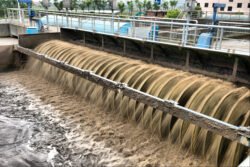
The Beixiaohe Wastewater Treatment Plant: A Model of Sustainability for Beijing
As China’s capital Beijing continues its unprecedented urban expansion, the city’s environmental and public health demands grow in turn. With over 20 million residents, Beijing generates staggering volumes of sewage and wastewater that must be treated and discharged responsibly. At the forefront of Beijing’s wastewater infrastructure stands the Beixiaohe Treatment Plant – an engineering marvel adopting cutting-edge technologies and sustainable practices to safeguard the region’s water resources for future generations.
Monumental Capacity Forged Through Decades
Originally constructed in 1958, the Beixiaohe Wastewater Treatment Plant dates back to the earliest days of Beijing’s transition into a modern megacity. Over the past 60 years, the plant has undergone numerous expansions to increase its treatment capacity in stride with the capital’s booming population growth. Today, Beixiaohe stands as one of Beijing’s largest wastewater facilities, processing an incredible one million cubic meters of influent each day.
Beixiaohe’s expansive treatment operations span an area larger than 30 football fields in the city’s northeastern suburbs. An intricate network of trunk sewers stretching over 50 kilometers across northern Beijing feeds the influent into the plant’s advanced treatment systems. Hundreds of thousands of residents rely directly on Beixiaohe’s treatment capabilities to handle domestic and industrial wastewater before it can be safely discharged as clean effluent.
A Multi-Stage Treatment Arsenal
Once influent reaches the Beixiaohe plant, it undergoes a multi-stage treatment process to remove pollutants and purify the water streams. After passing through preliminary screening to filter out large solids, the water enters primary sedimentation tanks where suspended particles settle out as sludge. This initial sludge is thickened and dewatered before being transported offsite for conversion into environmentally-friendly fertilizer pellets.
The wastewater then advances to Beixiaohe’s secondary treatment phase, which utilizes an activated sludge process incorporating aeration tanks. Here, microbes are cultivated to feed on organic matter and breaking down contaminants within the oxygen-rich environments. After microorganisms and suspended solids are settled out, the water progresses to the final disinfection and filtration stages.
This tertiary treatment process represents where Beixiaohe truly elevates itself as a global leader in wastewater engineering. The plant employs an advanced submerged membrane bioreactor system – the first of its kind installed in northern China – capable of producing a superior-quality effluent meeting China’s most stringent Grade 1A standards.
Cutting-Edge Membrane Reactors
Membrane bioreactor (MBR) technology integrates membrane filtration into the biological treatment steps, resulting in highly effective pathogen removal and purified discharge water. At Beixiaohe, the membrane modules consist of thousands of permeable polyethylene membrane tubes submerged within the aeration tanks. As activated sludge circulates around the membranes, a vacuum effect draws the treated water through the membrane pores, filtering out virtually all impurities and microscopic contaminants.
This bundled membrane configuration offers self-scouring properties for reduced fouling and efficient operation. Individual membrane tubes are also easily extracted for maintenance purposes when needed. Through this innovative MBR process, the Beixiaohe plant has positioned itself as one of the most technologically-sophisticated wastewater facilities across China.
Prioritizing Sustainability and Resource Recovery
Beyond advanced treatment capabilities, the Beixiaohe Wastewater Treatment Plant exemplifies state-of-the-art sustainability in action. Designers incorporated numerous environmentally-conscious elements and resource recovery systems to minimize the plant’s carbon footprint and external energy demands.
One of Beixiaohe’s key sustainable features involves an effluent heat pump network harnessing residual thermal energy from the treated discharge streams. This recycled heat fulfills over 60% of the plant’s heating requirements during Beijing’s frigid winter months – a remarkable achievement in energy efficiency. The sludge drying and pelletizing operations also derive process heat from the combustion of nutrient-rich biogas captured onsite.
Speaking of biogas, the Beixiaohe plant maximizes its own circular economy through beneficial reuse of this renewable fuel source. Digesters generate biogas by anaerobically breaking down organic matter within the sludge streams. This captured methane powers the energy-intensive membrane reactor processes in place of electricity drawn from the municipal grid.
The membrane bioreactor technology itself further contributes to sustainability by requiring up to 50% less energy compared to conventional activated sludge treatment methods. As environmental regulations in Beijing continue tightening, efficiency advantages like these will only grow more vital.
An Expanding Mission in the Circular Economy
To build upon its sustainable foundation, the Beixiaohe plant is currently in the midst of a major expansion targeting organic waste recycling and the circular economy. With Beijing’s residents producing over 6 million tons of food waste annually, this new phase aims to co-locate large-scale facilities for pre-processing kitchen scraps collected across the city.
An entire section of the plant is being constructed with the capability to receive over 500 tons per day of source-separated food waste streams. This organic material will undergo hydrolysis to break down polymeric compounds, followed by dewatering, anaerobic digestion, and curing to stabilize the treated solids. The process will generate nutrient-rich soil amendments for agricultural applications as well as yielding recoverable biogas to be utilized as a renewable fuel source.
Implementing comprehensive food waste recycling operations will allow the Beixiaohe plant to further reduce Beijing’s outgoing municipal solid waste volumes while harnessing embodied energies and keeping resources in productive circles of use. These circular economy practices align with China’s long-term sustainability roadmap of reaching peak carbon emissions before 2030 and carbon neutrality by 2060.
The Environmental Backbone of an Urban Juggernaut
There’s no denying the Beixiaohe Wastewater Treatment Plant’s role as the backbone of environmental protection and public health for Beijing’s estimated 20 million residents. This engineering colossus will only continue growing in scope and importance as the capital city expands over the coming decades.
By prioritizing sustainable design, cutting-edge treatment technologies, and resource recovery principles, the Beixiaohe facility stands out as a model worth emulating across China and internationally. Wastewater utilities would be wise to mimic this plant’s marriage of membrane bioreactors with heat reuse, biogas capture, and organic waste recycling streams. Through such foresight, megacities like Beijing can continue prospering economically while enhancing environmental resiliency and water quality for generations ahead.


